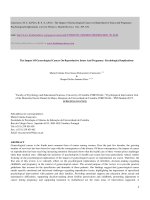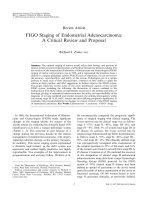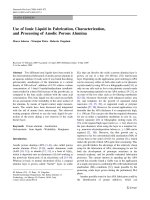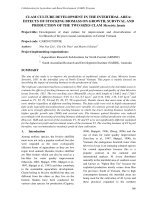Management principles of sustainable industrial chemistry theories concepts and industrial examples for achieving sustainable chemical products and processes from a non technological viewpoint
Bạn đang xem bản rút gọn của tài liệu. Xem và tải ngay bản đầy đủ của tài liệu tại đây (1.99 MB, 281 trang )
Edited by
Genserik L.L. Reniers, Kenneth S¨orensen,
and Karl Vrancken
Management Principles
of Sustainable Industrial Chemistry
Related Titles
Azapagic, A., Perdan, S. (eds.)
¨
Leimkuhler,
H.-J. (ed.)
Sustainable Development
in Practice
Managing CO2 Emissions in the
Chemical Industry
Case Studies for Engineers and Scientists
2011
Softcover
ISBN: 978-0-470-71872-8
Yasuda, N. (ed.)
The Art of Process Chemistry
2011
Hardcover
ISBN: 978-3-527-32470-5
2010
Hardcover
ISBN: 978-3-527-32659-4
Centi, G., Trifir´o, F., Perathoner, S.,
Cavani, F. (eds.)
Sustainable Industrial
Chemistry
2009
Hardcover
ISBN: 978-3-527-31552-9
Edited by Genserik L.L. Reniers, Kenneth S¨orensen,
and Karl Vrancken
Management Principles of Sustainable
Industrial Chemistry
Theories, Concepts and Industrial Examples for Achieving
Sustainable Chemical Products and Processes
from a Non-Technological Viewpoint
The Editors
Prof. Genserik L.L. Reniers
Universiteit Antwerpen
City Campus, Office B-434
Prinsstraat 13
2000 Antwerpen
Belgien
Prof. Kenneth S¨
orensen
University of Antwerp
Operation Res. Group ANT/OR
Prinsstraat 13
2000 Antwerpen
Belgien
Prof. Karl Vrancken
University of Antwerp
Dept. Bio-Engineering
Boeretang 200
2400 Mol
Belgien
All books published by Wiley-VCH are
carefully produced. Nevertheless, authors,
editors, and publisher do not warrant the
information contained in these books,
including this book, to be free of errors.
Readers are advised to keep in mind that
statements, data, illustrations, procedural
details or other items may inadvertently be
inaccurate.
Library of Congress Card No.: applied for
British Library Cataloguing-in-Publication
Data
A catalogue record for this book is available
from the British Library.
Bibliographic information published by the
Deutsche Nationalbibliothek
The Deutsche Nationalbibliothek
lists this publication in the Deutsche
Nationalbibliografie; detailed bibliographic
data are available on the Internet at
<>.
© 2013 Wiley-VCH Verlag & Co. KGaA,
Boschstr. 12, 69469 Weinheim, Germany
All rights reserved (including those of
translation into other languages). No part
of this book may be reproduced in any
form – by photoprinting, microfilm, or any
other means – nor transmitted or translated
into a machine language without written
permission from the publishers. Registered
names, trademarks, etc. used in this book,
even when not specifically marked as such,
are not to be considered unprotected by law.
Print ISBN: 978-3-527-33099-7
ePDF ISBN: 978-3-527-64951-8
ePub ISBN: 978-3-527-64950-1
mobi ISBN: 978-3-527-64949-5
oBook ISBN: 978-3-527-64948-8
Cover Design Grafik-Design Schulz,
Fußg¨onheim, Germany
Typesetting Laserwords Private Limited,
Chennai, India
Printing and Binding Markono Print Media
Pte Ltd, Singapore
V
Contents
Preface XIII
List of Contributors
Part I
1
1.1
1.2
1.3
1.4
1.5
2
2.1
2.1.1
2.1.2
2.2
2.2.1
2.2.2
2.2.3
2.3
2.3.1
2.3.2
2.3.3
2.4
XV
Introductory Section 1
Editorial Introduction 3
Genserik L.L. Reniers, Kenneth S¨orensen, and Karl Vrancken
From Industrial to Sustainable Chemistry, a Policy Perspective
Managing Intraorganizational Sustainability 5
Managing Horizontal Interorganizational Sustainability 5
Managing Vertical Interorganizational Sustainability 6
Sustainable Chemistry in a Societal Context 6
History and Drivers of Sustainability in the Chemical Industry 7
Dicksen Tanzil and Darlene Schuster
The Rise of Public Pressure 7
The Environmental Movement 8
A Problem of Public Trust 9
Industry Responded 10
The Responsible Care Program 10
Technology Development 12
Corporate Sustainability Strategies 14
An Evolving Framework 15
New Issues and Regulations 15
Sustainability as an Opportunity 16
Recent Industry Trends 16
Conclusions: the Sustainability Drivers 18
References 18
4
VI
Contents
3
3.1
3.2
3.2.1
3.2.2
3.2.3
3.3
3.4
3.4.1
3.4.2
3.4.3
3.5
4
4.1
4.2
4.3
4.4
4.5
4.6
From Industrial to Sustainable Chemistry, a Policy Perspective 21
Karl Vrancken and Frank Nevens
Introduction 21
Integrated Pollution Prevention and Control 22
Environmental Policy for Industrial Emissions 22
Best Available Techniques and BREFs 23
Integrated Pollution Prevention and Control in the Chemical
Sector 24
From IED to Voluntary Systems 25
Sustainability Challenges for Industry 26
Introduction 26
Policy Drivers for Sustainable Chemistry 27
Transition Concept 28
Conclusion 30
References 31
Sustainable Industrial Chemistry from a Nontechnological
Viewpoint 33
Genserik L.L. Reniers, Kenneth S¨orensen, and Karl Vrancken
Introduction 33
Intraorganizational Management for Enhancing Sustainability
Horizontal Interorganizational Management for Enhancing
Sustainability 37
Vertical Interorganizational Management for Enhancing
Sustainability 38
Sustainable Chemistry in a Societal Context 39
Conclusions 40
References 41
Part II
5
5.1
5.2
5.2.1
5.2.2
5.2.3
5.2.4
5.2.5
5.3
36
Managing Intra-Organizational Sustainability 43
Building Corporate Social Responsibility – Developing a Sustainability
Management System Framework 45
Stefan Maas, Genserik L.L. Reniers, and Marijke De Prins
Introduction 45
Development of a CSR Management System Framework 47
Management Knowledge and Commitment (Soft Factor) 49
Stakeholder Knowledge and Commitment (Soft Factor) 49
Strategic Planning – the Choice of Sustainable Strategic Pillars
(Hard Factor) 50
Knowledge and Commitment from the Workforce (Soft Factor) 50
Operational Planning, Execution, and Monitoring (Hard Factor) 51
Conclusions 52
References 52
Contents
6
6.1
6.2
6.3
6.3.1
6.3.1.1
6.3.1.2
6.3.1.3
6.3.1.4
6.3.2
6.3.2.1
6.3.2.2
6.3.3
6.3.3.1
6.3.3.2
6.3.4
6.3.5
6.4
7
7.1
7.2
7.3
7.4
7.4.1
7.4.2
7.4.3
7.4.4
7.5
7.6
8
8.1
8.2
8.3
8.4
Sustainability Assessment Methods and Tools 55
Steven De Meester, Geert Van der Vorst, Herman Van Langenhove,
and Jo Dewulf
Introduction 55
Sustainability Assessment Framework 56
Impact Indicators and Assessment Methodologies 59
Environmental Impact Assessment 62
Emission Impact Indicators 62
Resource Impact Indicators 68
Technology Indicators 71
Assessment Methodologies 72
Economic Impact Assessment 75
Economic Impact Indicators 76
Assessment Methodologies 76
Social Impact Assessment 77
Social Impact Indicators 78
Assessment Methodologies 79
Multidimensional Assessment 79
Interpretation 81
Conclusions 81
References 82
Integrated Business and SHESE Management Systems 89
Kathleen Van Heuverswyn and Genserik L.L. Reniers
Introduction 89
Requirements for Integrating Management Systems 90
Integrating Management Systems: Obstacles and Advantages 92
Integrated Risk Management Models 95
FERMA Risk Management Standard 2003 95
Australian/New Zealand Norm AS/NZS 4360:2004 96
ISO 31000:2009 97
The Canadian Integrated Risk Management Framework
(IRM Framework) 98
Characteristics and Added Value of an Integrated Model; Integrated
Management in Practice 100
Conclusions 103
References 103
Supporting Process Design by a Sustainability KPIs Methodology 105
Alessandro Tugnoli, Valerio Cozzani, and Francesco Santarelli
Introduction 105
Quantitative Assessment of Sustainability KPIs in Process Design
Activities 107
Identification of Relevant KPIs: the ‘‘Tree of Impacts’’ 111
Criteria for Normalization and Aggregation of the KPIs 121
VII
VIII
Contents
8.5
8.6
Customization and Sensitivity Analysis in Early KPI Assessment 123
Conclusions 128
References 128
Part III
Managing Horizontal Interorganizational
Sustainability 131
9
9.1
9.2
9.2.1
9.2.2
9.2.3
9.3
9.4
9.4.1
9.4.2
9.4.3
9.5
10
10.1
10.2
10.3
10.3.1
10.3.2
10.3.3
10.4
10.5
Industrial Symbiosis and the Chemical Industry: between Exploration
and Exploitation 133
Frank Boons
Introduction 133
Understanding Industrial Symbiosis 134
Industrial Symbiosis Leads to Decreased Ecological Impact 135
Industrial Symbiosis Requires a Highly Developed Social
Network 136
The Regional Cluster Is the Preferred Boundary for Optimizing
Ecological Impact 136
Resourcefulness 137
Putting Resourcefulness to the Test 138
Petrochemical Cluster in the Rotterdam Harbor Area 138
Terneuzen 139
Moerdijk 141
Conclusions 142
References 144
Cluster Management for Improving Safety and Security in Chemical
Industrial Areas 147
Genserik L.L. Reniers
Introduction 147
Cluster Management 148
Cross-Organizational Learning on Safety and Security 150
Knowledge Transfer 150
Overcoming Confidentiality Hurdles: the Multi-Plant Council
(MPC) 151
A Cluster Management Model for Safety and Security 152
Discussion 157
Conclusions 158
References 159
Part IV
11
11.1
11.2
Managing Vertical Inter-Organizational Sustainability 161
Sustainable Chemical Logistics 163
Kenneth S¨orensen and Christine Vanovermeire
Introduction 163
Sustainability of Logistics and Transportation 165
Contents
11.3
11.3.1
11.3.2
11.3.3
11.3.4
11.4
Improving Sustainability of Logistics in the Chemical Sector 166
Optimization 167
Coordinated Supply Chain Management 170
Horizontal Collaboration 171
Multimodal, Intermodal and Co-Modal Transportation 174
Conclusions 178
References 179
12
Implementing Service-Based Chemical Supply Relationship – Chemical
Leasing® – Potential in EU 181
Bart P.A. Van der Velpen and Marianne J.J. Hoppenbrouwers
Introduction 181
Basic Principles of Chemical Leasing (ChL) 182
Differences between Chemical Leasing and Other Alternative
Business Models for Chemicals 186
Classical Leasing 186
Chemical Management Services 186
Outsourcing 187
Practical Implications of Chemical Leasing 187
Strengths and Opportunities for the Supplier 189
Strengths and Opportunities for the Customer 190
Economic, Technical, and Juridical Aspects of Chemical Leasing 191
An Example 191
Barriers to the Model 191
Analysis of the Legal Requirements Impacting Chemical Leasing
Projects 193
The Importance of Contracts 193
Competition Law and Chemical Leasing 194
REACH and Chemical Leasing 195
Legal Aspects, a Bottleneck? 196
Conclusions and Recommendations 197
References 198
12.1
12.2
12.3
12.3.1
12.3.2
12.3.3
12.4
12.4.1
12.4.2
12.5
12.5.1
12.5.2
12.5.3
12.5.3.1
12.5.3.2
12.5.3.3
12.5.3.4
12.6
13
13.1
13.2
13.2.1
13.2.2
13.2.3
13.2.3.1
13.2.3.2
13.2.3.3
Sustainable Chemical Warehousing 199
Kenneth S¨orensen, Gerrit K. Janssens, Mohamed Lasgaa,
and Frank Witlox
Introduction 199
Risk Management in the Chemical Warehouse 200
Hazard Identification 200
Quantifying Risk: Probabilities and Consequences 205
Mitigation Strategies 209
Minimize Risk 209
Transfer Risk 211
Accept Risk 213
IX
X
Contents
13.2.4
13.3
Control and Documentation 213
Conclusions 214
References 214
Part V
14
14.1
14.2
14.3
14.4
14.5
14.6
15
15.1
15.1.1
15.1.2
15.1.3
15.2
15.2.1
15.2.2
15.2.2.1
15.2.2.2
15.2.2.3
15.2.3
15.3
Sustainable Chemistry in a Societal Context 215
A Transition Perspective on Sustainable Chemistry: the Need for Smart
Governance? 217
Derk A. Loorbach
Introduction 217
A Transitions Perspective on Chemical Industry 219
A Tale of Two Pathways 223
Critical Issues in the Transition Management to Sustainable
Chemistry 225
Governance Strategies for a Transition to a Sustainable
Chemistry 227
Conclusions and Reflections 230
References 231
The Flemish Chemical Industry Transition toward Sustainability:
the ‘‘FISCH’’ Experience 233
Luc Van Ginneken and Frans Dieryck
Introduction 233
Societal Chemistry 233
The Belgian and Flemish Chemical and Life Sciences Industry in a
Global Context 233
The Challenge of Sustainable Development for the Chemical Industry
in Flanders 234
Transition of the Chemical Industry in Flanders: the ‘‘FISCH’’
Initiative 236
Setting the Scene: the ‘‘FISCH’’ Feasibility Study 236
Outcome of the Study – Goals and Overall Setup of ‘‘FISCH’’ 237
Vision, Mission, and Setup of FISCH 237
FISCH in a Flemish and European Context 241
Added Value of ‘‘FISCH’’ and Spillover Effects 242
Putting It All into Practice: Implementing ‘‘FISCH’’ 243
Concluding Remarks and Lessons Learned 244
Acknowledgments 245
References 245
Contents
16
16.1
16.2
16.2.1
16.2.2
16.3
16.3.1
16.3.2
16.3.3
16.4
The Transition to a Bio-Based Chemical Industry: Transition
Management from a Geographical Point of View 247
Nele D’Haese
Introduction 247
Composition of the Chemical Clusters in Antwerp, Ghent, Rotterdam,
and Terneuzen 249
The Rhine–Scheldt Delta 249
Past and Present of the Petrochemical Industry in the Ports of
Antwerp, Ghent, Rotterdam, and Terneuzen 250
Regional Innovation Projects to Strengthen the Transition to a
Bio-Based Chemical Industry 254
First Step: Substitution of Fossil Resources by Bio-Based Feedstocks
Making Use of Vested Technologies 254
Second Step: Development of a New Technological Paradigm for the
Production of Second-Generation Bio-Based Products 257
Third Step: Closing Material Loops 258
Conclusions 259
References 262
Part VI
17
Conclusions and Recommendations 265
Conclusions and Recommendations 267
Genserik L.L. Reniers, Kenneth S¨orensen, and Karl Vrancken
Index 269
XI
xiii
Preface
Chemical products make an irreplaceable contribution in every aspect of our
modern day lives. Chemical processes and products play an essential role in
industrial sectors as diverse as agriculture, automotive, clothing, communication,
construction, food, health, leisure, mobility, plastics, space, transport, and so on.
We can easily observe that our advanced society depends on the wealth-creating
aspects of industrial chemistry.
Nonetheless, societal expectations and the depletion of natural resources are
pushing toward chemical processes becoming cleaner, more efficient, less consuming, safer, and more secured. The ecological footprint of chemical products
needs to be decreased.
Sustainable chemistry being concerned with the development of sustainable
chemical products and processes and thereby integrating economic, environmental,
and social performance, can provide an answer to these major challenges.
To achieve sustainable industrial chemical processes and products, companies,
research centers, and academia tend to focus mainly on technological solutions such
as cleantech, green technology, process intensification, new catalysts, new membranes, ecofining, and so on. However, nontechnological approaches are essential
as well to succeed in adequate sustainable chemistry. Integrated management
systems, cluster management, business models, measuring criteria and methods,
sustainable supply chain management, chemical leasing, transition management,
societal expectations, and so on are all important nontechnological aspects of
sustainable chemistry. To date, most of the know-how and expertise on nontechnological issues is developed on individual company or academia basis and in a
fragmented way. An overview of management principles, theories, concepts, and
so on from a nontechnological holistic (People, Planet, and Profit) perspective has,
to the best of the Editors’ knowledge, not yet been discussed in one book volume.
The objective of writing a book from a managerial viewpoint consists in leveraging
the search for truly sustainable chemical products and processes, and to disseminate
the available knowledge to captains of industry and to leaders of the public sector,
as well as to company management (within all organizational levels and from all
different departments, and disciplines). It is crucial for the vision of sustainable
chemistry to be realized that not only novel technology is conceptualized and
xiv
Preface
developed but also that innovative management models, intraorganization models,
and interorganization models are elaborated, promoted, and implemented within
the chemicals using industries.
We are convinced that a clear interdisciplinary approach within technological
areas, supported by cross-cutting managerial actions, is required for truly successful
tackling of these new chemistry challenges and paradigms.
Antwerp
May 10, 2012
Genserik L.L. Reniers, Kenneth S¨orensen,
and Karl Vrancken
XV
List of Contributors
Frank Boons
Erasmus University Rotterdam
Department of Public
Administration
Post Box 1738
3000 DR Rotterdam
The Netherlands
Valerio Cozzani
Alma Mater Studiorum –
University of Bologna
Dipartimento di Ingegneria
Chimica Mineraria e delle
Tecnologie Ambientali (DICMA)
via Terracini 28
40131 Bologna (BO)
Italy
Jo Dewulf
Research Group ENVOC
Ghent University
Coupure Links
9000 Ghent
Belgium
Nele D’Haese
Flemish Institute for
Technological Research (VITO)
Boeretang 200
2400 Mol
Belgium
Frans Dieryck
essenscia vlaanderen
Diamant Building
A. Reyerslaan 80
1030 Brussels
Belgium
Marianne J.J. Hoppenbrouwers
Universiteit Hasselt
Centrum voor Milieukunde
Campus Diepenbeek
3590 Diepenbeek
Belgium
Gerrit K. Janssens
University of Antwerp
Operation Research Group
ANT/OR
Prinsstraat 13
2000 Antwerp
Belgium
XVI
List of Contributors
Mohamed Lasgaa
University of Antwerp
Operation Research Group
ANT/OR
Prinsstraat 13
2000 Antwerp
Belgium
and
Groenewout
Nijverheidssingel 313
4800 DG Breda
The Netherlands
Derk A. Loorbach
Dutch Research Institute for
Transitions (DRIFT)
Erasmus University Rotterdam
PO Box 1738
3000 DR Rotterdam
The Netherlands
Stefan Maas
Univsersity of Antwerp
Antwerp Research Group on
Safety and Security ARGoSS
Chemistry Lab
City Campus
Koningstraat 8
2000 Antwerp
Belgium
Steven De Meester
Research Group ENVOC
Ghent University
Coupure Links
9000 Ghent
Belgium
Frank Nevens
Flemish Institute for
Technological Research (VITO)
Boeretang 200
2400 Mol
Belgium
Marijke De Prins
HUB, Stormstraat 2
1000 Brussels
Belgium
Genserik L.L. Reniers
Univsersity of Antwerp
Antwerp Research Group on
Safety and Security ARGoSS
Chemistry Lab
City Campus
Koningstraat 8
2000 Antwerp
Belgium
Francesco Santarelli
Dipartimento di Ingegneria
Chimica
Mineraria e delle Tecnologie
Ambientali (DICMA)
Alma Mater Studiorum –
Universita` di Bologna
via Terracini 28
40131 Bologna (BO)
Italy
Darlene Schuster
Institute for Sustainability American Institute of Chemical
Engineers (AIChE)
3 Park Avenue 19 Fl
New York, NY 10016-5991
USA
List of Contributors
Kenneth S¨
orensen
University of Antwerp
Operation Research Group
ANT/OR
Prinsstraat 13
2000 Antwerp
Belgium
Dicksen Tanzil
Golder Associates Inc.
500 Century Plaza Dr. Ste. 190
Houston, TX 77073-6027
USA
Alessandro Tugnoli
Dipartimento di Ingegneria
Chimica
Mineraria e delle Tecnologie
Ambientali (DICMA)
Alma Mater Studiorum –
Universita` di Bologna
via Terracini 28
40131 Bologna (BO)
Italy
Luc Van Ginneken
Flemish Institute for
Technological Research (VITO)
Boeretang 200
2400 Mol
Belgium
Kathleen Van Heuverswyn
HUBrussel
Stormstraat 2
1000 Brussels
Belgium
Herman Van Langenhove
Research Group ENVOC
Ghent Univesity
Coupure Links
9000 Ghent
Belgium
Bart P.A. Van der Velpen
Royal HaskoningDHV
Schali¨enhoevedreef 20D
Hanswijkdries 80
2800 Mechelen
Belgium
Geert Van der Vorst
Research Group ENVOC
Ghent University
Coupure Links
9000 Ghent
Belgium
Christine Vanovermeire
University of Antwerp
Operations Research Group
ANT/OR
Prinsstraat 13
2000 Antwerp
Belgium
XVII
XVIII
List of Contributors
Karl Vrancken
Flemish Institute for
Technological Research (VITO)
Boeretang 200
2400 Mol
Belgium
Frank Witlox
Ghent University
Department of Geography
Krijgslaan 281, S8
B9000 Ghent
Belgium
and
and
University of Antwerp
Department Bio-Engineering
Groenenborgerlaan 171
2020 Antwerpen
Belgium
University of Antwerp - ITMMA
Kipdorp 59
B2000 Antwerp
Belgium
1
Part I
Introductory Section
Management Principles of Sustainable Industrial Chemistry: Theories, Concepts and Industrial Examples
for Achieving Sustainable Chemical Products and Processes from a Non-Technological Viewpoint,
First Edition. Edited by Genserik L.L. Reniers, Kenneth S¨orensen, and Karl Vrancken.
© 2013 Wiley-VCH Verlag GmbH & Co. KGaA. Published 2013 by Wiley-VCH Verlag GmbH & Co. KGaA.
3
1
Editorial Introduction
Genserik L.L. Reniers, Kenneth S¨orensen, and Karl Vrancken
There has been an ever-growing worldwide interest in sustainability in all industrial
sectors since the Rio declaration two decades ago (UN, 1992). Especially in industries
using chemicals, topics related to sustainability are gaining importance by the year.
Sustainability should be seen as an ideal. It is an objective of perfection that
will never be completely achieved. It is a target of continuous improvement. It
should be a business imperative. The interconnectedness of organizational actions
and decisions should have an impact on the social, ecological, and economic
sustainability of the community in which it operates. To achieve this ideal, and
all its accompanying aims, technological as well as a nontechnological innovations
and operations should be strived for and implemented. This book specifically deals
with the nontechnological path that should be taken within the chemical industry
to achieve sustainability in business needs.
However, these are rather vague concepts. All this wisdom about sustainability,
the awareness, and information, does not suggest concrete actions and tactics
needed to change an organization for the better. This book describes how to
significantly enhance the sustainability of chemical plants from the management’s
perspective.
By taking into consideration the needs for nontechnological advancements
toward sustainability, the present book, whose structure is illustrated in Figure 1.1,
aims at covering all aspects and all principles leading to truly sustainable industrial
chemistry from a managerial perspective. The first introductory section provides
a description of the history and importance of sustainability in the chemical
industry and of the evolution in managerial themes and models leading to a steady
transition toward sustainability. The second section discusses the management
system requirements and the needs to build corporate social responsibility within
one plant, and provides tools and methods to measure sustainability within a
chemical company or a part thereof. The third section investigates the managerial
needs to improve cross-plant management and collaboration at the same level of
the supply chain, for moving toward ever more sustainable chemical products and
processes. The fourth section provides insights into some innovative managerial
approaches with respect to collaboration and cooperation between organizations
not situated on the same level of the supply chain, leading toward so-called vertical
Management Principles of Sustainable Industrial Chemistry: Theories, Concepts and Industrial Examples
for Achieving Sustainable Chemical Products and Processes from a Non-Technological Viewpoint,
First Edition. Edited by Genserik L.L. Reniers, Kenneth S¨orensen, and Karl Vrancken.
© 2013 Wiley-VCH Verlag GmbH & Co. KGaA. Published 2013 by Wiley-VCH Verlag GmbH & Co. KGaA.
4
1 Editorial Introduction
Section 1:
From industrial to
sustainable chemistry
Section 2:
Managing
intraorganizational
sustainability
Section 3:
Managing horizontal
interorganizational
sustainability
Section 4:
Managing vertical
interorganizational
sustainability
Section 5:
Sustainable chemistry
in a societal context
Section 6:
Conclusions and
recommendations
Figure 1.1
Structure of the book.
interorganizational sustainability. The fifth section presents and elaborates on the
societal context of sustainable chemistry.
The following paragraphs offer an outlook of the 13 contributions that constitute
the various sections of the book. In order to provide an introduction to the various
chapters, a description of the main themes that are dealt with in each one is given.
1.1
From Industrial to Sustainable Chemistry, a Policy Perspective
This first, introductory, section contains three contributions. The first one, History
and Drivers of Sustainability in the Chemical Industry, provides a brief description
of the chemical industry’s path toward sustainability. The incentives and drivers for
a step-by-step advancement, from the Responsible Care® program to the various
corporate sustainability initiatives, are listed out and expounded.
The second contribution of this section, From Industrial to Sustainable Chemistry, a Policy Perspective, clarifies the policy developments that could be observed
over the past decades in relation to chemistry on an industrial scale. The contribution clearly demonstrates that there has been a shift in focus over the last two
decades from strict rule-driven regulations and authorities toward performancebased and stakeholder-based governance. This shift has initiated and empowered
a shift of industry – such as the chemical industry – toward new managerial and
governance approaches.
The third contribution of this introductory section, Sustainable Industrial Chemistry from a Nontechnological Viewpoint, briefly discusses what is understood in
this book by ‘‘sustainable chemistry’’ and what constitutes a ‘‘nontechnological
viewpoint.’’ The foundations are laid for the further chapters by elaborating on
1.3 Managing Horizontal Interorganizational Sustainability
the different managerial topics for achieving sustainable chemistry in a simple,
nontechnological manner.
1.2
Managing Intraorganizational Sustainability
The second section of the book is composed of four chapters. The first one, Building
Corporate Social Responsibility – Developing a Sustainability Management System
Framework, deals with the creation of a conceptual sustainability management
system, mainly on the basis of the umbrella guideline ISO 26000. The proposed
coherent and systematic framework contains five inherent and consecutive features
of sustainability. The current overload of standards makes organizations uncertain
how to translate the idea of sustainability optimally into a management system,
and this section provides an answer to this organizational need.
The second chapter of this section, Sustainability Assessment Methods and
Tools, discusses a sustainability assessment framework and impact indicators and
assessment approaches from both a uni- and a multidimensional perspectives.
The chapter argues that harmonization and standardization of knowledge in
three dimensions (environment, economic, and social) should be pursued for the
chemical industry.
The third contribution of this section, Integrated Business- and SHESE Management Systems, takes a closer look at the added value of integrated management
systems and the required steps to successfully implement an integrated management system approach. The chapter provides arguments for treating sustainability
as a holistic, organization-wide objective, to be achieved by an integrative generic
framework that leaves space for specificities wherever and whenever needed.
The last contribution is concerned with the identification of relevant impact
categories and suitable KPIs for sustainability performance. How the KPIs should
be interpreted and aggregated is explained, amongst others. The method elaborated
in this contribution helps decision makers in the design for sustainability within
chemical process plants.
1.3
Managing Horizontal Interorganizational Sustainability
The third section of the book is contains two chapters. The first chapter, Industrial
Symbiosis and the Chemical Industry: between Exploration and Exploitation,
explains industrial symbiosis and compares different chemical clusters from the
Netherlands in this regard. The advantages and hurdles of realizing cross-plant
collaboration initiatives to advance environmental symbiotic linkages are discussed.
The second contribution in this section, Cluster Management for Improving
Safety and Security in Chemical Industrial Areas, proposes a framework and an
approach for chemical plants situated within the same chemical cluster, to transfer
knowledge, know-how, and best practices, and a more intensive collaboration on
safety and security topics.
5
6
1 Editorial Introduction
1.4
Managing Vertical Interorganizational Sustainability
The fourth part of this book has three contributions. The first contribution,
Sustainable Chemical Logistics, investigates the status of sustainability in chemical
logistics, and argues that organizational aspects have an important role to play in
this area. Furthermore, different ways to improve sustainability of chemical logistics
are discussed: optimization in logistics, coordinated supply chain management,
horizontal collaboration, and intermodal transportation.
The second contribution, Implementing Service-Based Chemical Supply Relationship – Chemical leasing® – Potential in EU?, explains ‘‘chemical leasing’’ as a
new business model that aligns economic incentives in the chemical supplier–user
relationship toward reduced material use on the one hand and waste prevention
on the other. The contribution clarifies this novel business concept and shows its
innovative nature and possible role in ‘‘servicizing’’ the chemical supply chain.
Furthermore, the synergy that exists between chemical leasing and several relevant
legal frameworks, such as REACH, is addressed.
The third contribution deals with the needs as regards sustainable warehousing.
It is evident that adequate risk management policies and -procedures and risk
treatment strategies need to be in place in warehouses. The different factors
important in this regard, are given and clarified. The chapter further discusses
sustainable inventory management and vendor management inventory, and their
importance.
1.5
Sustainable Chemistry in a Societal Context
The fifth section of the book is based on three contributions. The first one, A
Transition Perspective on Sustainable Chemistry: the Need for Smart Governance,
offers an exploratory transition perspective on challenges and changes going hand
in hand with sustainable chemistry. The author argues and explains that a transition
toward sustainable industrial chemistry is not so much a technological challenge
as it is an institutional, economic, and political challenge.
The second chapter, The Flemish Chemical Industry Transition toward Sustainability: the ‘‘FISCH’’ Experience, discusses the peculiarities and the obstacles
and hurdles of developing an initiative in the Flanders’ region in Belgium, to
advance the chemicals-using industries toward becoming a sustainability-driven
and an innovation-driven industrial sector. Factors to be taken into account when
developing a similar initiative are given.
The third contribution, The Transition to a Bio-based Chemical Industry: Transition Management from a Geographical Point of View, analyzes the regional
characteristics and their influence on bio-based innovation. The chapter discusses
the hard and soft influential factors in this regard, and four cases are examined:
the port regions of Antwerp, Ghent, Rotterdam, and Terneuzen.
7
2
History and Drivers of Sustainability in the Chemical Industry
Dicksen Tanzil and Darlene Schuster
This section provides a historical look on the emergence of sustainability issues
and awareness in the chemical industry and how the industry has responded
to them, especially over the last 50 years. It describes industry’s initial reactive
response to the rising public and regulatory pressures, and how this has morphed
into the more proactive stance taken by leaders in the chemical industry today in
managing environmental, social, and economic issues. The history also illustrates
how addressing sustainability issues helps business to better manage risks and
capture opportunities for new markets and innovations.
2.1
The Rise of Public Pressure
At the birth of the modern chemical industry some 200 years ago with the beginning
of mass production of chemicals such as acids and bleaching powder, what we now
consider as ‘‘sustainability issues’’ were hardly on anyone’s mind. Natural resources
were thought to be plentiful, the environment was for industries to exploit, and
workers’ and community safety was little more than an afterthought. This mind-set
had stayed for most of those 200 years. While one can point to measures taken by
some early chemical manufacturers that benefited the environment or safety, such
as reducing products released to rivers or in the workplace, those examples are few
and far between.
Through its history, the chemical industry has certainly made important contributions to society. Fertilizers and other agricultural chemicals increase crop
production, synthetic polymers make various new industrial products possible,
and mass production of medicines saves lives – just to name a few. Nevertheless,
the advancement of the chemical industry was accompanied with growing environmental concerns. Early examples include documented cases of water pollution
from chemical plants in the early twentieth century, which led to the 1935 listing of
the chemical industry as among the most polluting industries in the United States
by the country’s National Resources Committee (Geiser, 2005). Yet, the state and
Management Principles of Sustainable Industrial Chemistry: Theories, Concepts and Industrial Examples
for Achieving Sustainable Chemical Products and Processes from a Non-Technological Viewpoint,
First Edition. Edited by Genserik L.L. Reniers, Kenneth S¨orensen, and Karl Vrancken.
© 2013 Wiley-VCH Verlag GmbH & Co. KGaA. Published 2013 by Wiley-VCH Verlag GmbH & Co. KGaA.
8
2 History and Drivers of Sustainability in the Chemical Industry
federal governments in the United States remained slow in enacting environmental
or public health policies in spite of the growing concerns.
2.1.1
The Environmental Movement
Many would point to the 1960s as the turnaround, with the chemical industry
becoming a primary target of a growing environmental movement (Hoffman,
1999). Many attributed the rise of the public pressure on the chemical industry to
the publication of the book Silent Spring by Rachel Carson (1962) and the controversy
that followed (e.g., Gottlieb, 1993). Silent Spring meticulously presented the adverse
environmental effects from the indiscriminate use of the chemical pesticide DDT
and became an immediate best seller in the United States. Beyond questioning the
safety of synthetic pesticides, the book brought up concerns on the widespread use
of synthetic chemicals without fully understanding their potential impacts to the
environment and human health. The discovery of 5 million dead fish in the lower
Mississippi River later that year, which was attributed to the insecticide endrin,
further exacerbated the public concern. Pesticide manufacturers and others in the
chemical industry reacted strongly and negatively to the book and the public concern
(Natural Resources Defense Council, 1997). The reaction, however, appeared to
have largely backfired and further elevated the issues to a high-profile national
discourse on the potential environmental and public safety impacts of synthetic
chemicals.
The rising public pressure associated with the environmental movement of
the 1960s resulted in the many new environmental bills brought to the floor
of the US Congress. The National Environmental Policy Act (NEPA) was passed
by the US Congress in 1969, and signed by President Nixon on 1 January,
1970. The United States Environment Protection Agency (USEPA) was formed
shortly after. It was followed by the proliferation of environmental regulations
passed by the US Congress. The Clean Air Act, Occupational Safety and Health
Act, Clean Water Act, Safe Drinking Water Act, Consumer Product Safety Act,
Resource Conservation and Recovery Act, and Toxic Substances Control Act were all
passed between 1970 and 1976, often with strong bipartisan support in the US
Congress.
Many European countries and Japan enacted similar regulations during the
same period (Desai, 2002). These regulations affected the chemical industry as
well as many other industries. Among these regulations, the Toxic Substances
Control Act and the similar 1979 Sixth Amendment to the Dangerous Substances
Directive of the European Community were particularly directed to the chemical
industry. These regulations address the intrinsic hazards of chemical products
and provide government agencies with the authority to demand health and
safety data on chemical products and restrict the use of chemical substances
so as to reduce ‘‘unreasonable risks’’ to the public and the environment (Geiser,
2005).
2.1 The Rise of Public Pressure
2.1.2
A Problem of Public Trust
A series of industrial incidents and controversies in the late 1970s and early 1980s
further elevated the public awareness on the environmental and public safety risks
posed by industries in general. These include the Amoco Cadiz oil spill off the
coast of Brittany, France, in 1978 and the Three Mile Island nuclear incident in
Pennsylvania, United States, in 1979. Three incidents and controversies involving
chemical products and processes particularly stood out in their impact on the
public perception of the chemical industry: a train derailment in Canada, the
Bhopal chemical disaster in India, and the Love Canal controversy in the United
States.
The train derailment incident occurred in December 1979 in Mississauga, a
major business and residential suburb of Toronto, Canada. While the chemical
industry was not directly responsible, the transportation incident drew additional
public attention on the environmental and societal impacts of chemical products
and the industry that makes them. The train derailment resulted in the rupture of
several tankers carrying chlorine, propane, styrene, toluene, and caustic soda and
a fireball explosion that rose to a height of 1500 m visible 100 km away (City of
Mississauga, undated). Because of concern of a possible spread of toxic chlorine gas
cloud, 218 000 residents were evacuated, making it the largest peacetime evacuation
in North America at the time.
The Union Carbide incident in Bhopal, India, ignited even greater global public
controversy due to its massive impact. Just after midnight on 3 December, 1984,
water contamination of a tank of methyl isocyanate (MIC) in Bhopal, India,
initiated a series of events that led to a catastrophic toxic release, killing more
than 3000 residents and injuring over 100 000. According to Indian Government
estimates, the incident resulted in an immediate death toll of over 2500 people.
More recent government estimates puts the long-term mortality at of 14 400
people and permanent disabilities to about 50 000 people due to exposure to the
MIC toxic cloud (Lapierre and Moro, 2001). Other independent estimates put the
figures higher. However, for sure, the Bhopal disaster constituted one of the worst
industrial disasters of all time.
Along with these high-profile incidents, other controversies related to chronic
chemical exposure also posed problems to the chemical industry. Most infamous
among these is the Love Canal controversy toward the end of the 1970s. Residents
of the Love Canal neighborhood of Niagara Falls, New York, were found to have
unusually high rates of miscarriages and birth defects as well as toxin content
in breast milk, which were attributable to the long-term exposure to hazardous
chemicals released from a nearby decades-old chemical waste dump. The Love
Canal controversy led to the passage of the 1980 Comprehensive Environmental
Response Compensation and Liability Act (CERCLA, or the ‘‘Superfund’’ Act) in the
United States. Among others, the ‘‘Superfund’’ Act assigns liability for the release
of hazardous chemicals from a waste site and provides a trust fund for the cleanup
of contaminated areas when no responsible party can be identified.
9









